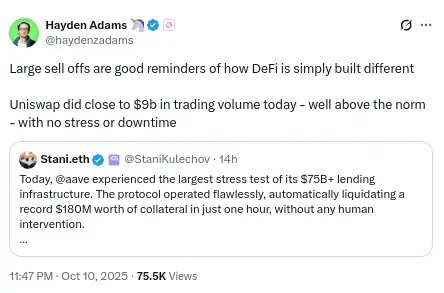
The crypto market has suffered its largest sell-off in history: more than $19.000 billion in 24 hours, driven by macroeconomic tensions and extreme leverage.
October 11, 2025, will go down as one of the most turbulent days for the cryptocurrency ecosystem. In just 24 hours, the market witnessed the largest liquidation of leveraged positions in its history, with more than $19.300 billion eliminated, according to data from CoinGlass.
The magnitude of this sell-off has surprised even veteran analysts, who warned of the risk of further declines if sentiment fails to stabilize.
The downward pressure on the market was unleashed after the announcement by the President of the United States, Donald Trump, of imposing a 100% tariff on Chinese products from November 1This news set off alarm bells in global markets, including the cryptocurrency market, causing an immediate shift towards risk aversionIn a matter of minutes, Bitcoin fell to $105.000 before recovering some ground and stabilizing around $112.000, where it currently trades. Ethereum, meanwhile, fell more than 13%, trading above $3.500, while Solana plummeted 15% to $186.
Hold Bitcoin Now: Weather the Storm and Build Your FutureTrump's trade coup shook Bitcoin and wiped out billions in crypto
The initial reaction was marked by the impact of the tariffs announced by WashingtonFears of a renewed escalation in the trade war with China triggered sell-offs in risky assets, from tech stocks to cryptocurrencies. Forbes reported that traders began preparing for further declines in Bitcoin amid uncertainty over trade measures.
In the case of cryptoassets, the market structure amplified the blow. Most traders held long positions with high leverage, betting on continued bullishness after weeks of relative stabilityWhen the Bitcoin price broke through support levels, automatic liquidations were triggered, triggering a domino effect.
CoinGlass data confirms that, In Bitcoin alone, $5.340 billion in long positions were liquidated., while on Ethereum the figure reached $4.390 billion.

Source: CoinGlass
But these massive liquidations weren't limited to the top two cryptocurrencies. In fact, Solana saw over $2.000 billion in long liquidations, while XRP and Cardano suffered losses of between 16% and 20% in a matter of hours. Market sentiment turned strongly bearish, with risk appetite practically evaporating in the main altcoins in recent hours.
Turn the dip into opportunity. Enter and trade crypto here.Leverage at its limit: a wave of liquidations unleashed chaos in the market
For experts, the market correction was not only a consequence of a macroeconomic shock, but also of structural fragility. excessive leverage left millions of traders exposed to sudden movements. According to CoinGlass data, more than 1,67 million accounts were liquidated in a single day, reflecting the magnitude of the forced deleveraging that hit the industry on October 11.
It all happened in a matter of hours. The initial sales triggered an accelerated price drop, which in turn triggered margin calls and automatic liquidations. These orders were executed on increasingly empty order books, triggering a domino effect. With each liquidation, liquidity disappeared and the price continued to fall, fueling a downward spiral that affected both the futures and spot markets.
Data shows that the balance of insurance funds in Bitcoin, Ethereum and BNB margined contracts fell from $1.230 billion to $1.040 billion, with $188 million deployed to covering risks amid volatilityAlthough these mechanisms prevented a major collapse, the reduction in reserves reflects the extreme pressure that derivatives platforms have faced.
In parallel, regulated financial products also showed signs of stress. The Soso Value platform, which tracks capital movements in the crypto exchange-traded fund market, shows that Ethereum spot ETFs recorded net outflows of $175 million on October 10, while Bitcoin ETFs saw outflows of $4,5 million, with a single net inflow into BlackRock's IBIT fund. These outflows reduced institutional demand at a critical time, reinforcing the downward pressure.

Source: Soso Value
Consolidation comes after the storm: the crypto market withstands the blow
The abrupt decline in the crypto market left a clear mark on investor sentiment. Key technical indicators, such as the RSI and MACD for Bitcoin and Ethereum, reflected oversold levels, a sign of a temporary capitulation. According to analysts cited by Bloomberg and CoinDesk, the magnitude of the sell-offs could trigger further selling if confidence fails to recover soon.
However, not everything has been negative this day. The market's decentralized infrastructure showed resilience amid the chaos. Uniswap founder Hayden Adams he highlighted that your protocol processed nearly $9.000 billion in volume in a single day, without interruptions or operational stressAccording to Adams, Uniswap's performance contrasted with the fragility of leveraged markets and was a reminder of the ability of DeFi systems to absorb spikes in activity.

In addition, some investors also managed to capitalize the crypto market crash. The analytics firm Lookonchain reported that a crypto whale obtained more than $160 million in profits after opening short positions worth over $1.100 billion in Bitcoin and Ethereum. This move illustrates how defensive strategies can thrive in highly volatile environments, even when most retail traders are suffering massive losses.

The Solana network also demonstrated technical capacity by processing over 10.000 transactions per second during the peak volatility, enabling real-time order execution despite market pressure. This operational performance prevented further delays and contributed to the rapid completion of the deleveraging.
Buy BTC today at Bit2Me: build on stronger foundationsThe Great Crypto Market Purge: the lesson of October 11
The crypto market is now facing a scenario of uncertainty. Total market capitalization has dropped dramatically, to about 3,8 trillions of dollars, and liquidity remains fragmented. Analysts note that the recovery will depend on factors such as the evolution of trade policy between the United States and China, the behavior of flows into ETFs and regulated products, and the ability of futures markets to normalize funding rates and order book depth.
In the short term, the prices of major cryptoassets could remain under pressure if capital outflows and bearish sentiment persist. However, technical overselling opens the possibility of temporary rebounds, especially if institutional buyers find attractive entry levels.
In short, the October 11 episode provides a clear lesson about the risks of excessive leverage in the face of external shocks. The combination of macroeconomic factors, limited liquidity, and speculative positions created a scenario of abrupt correction that wiped out billions in a matter of hours.
While technological infrastructure and decentralized protocols have proven resilient, attention now turns to the sector's ability to stabilize amidst commercial and financial uncertainty.
The crypto market has shown its resilience in the past following bouts of high volatility. However, investors are now wondering whether the purge of leveraged positions will be an opportunity to build a more solid foundation or, on the contrary, mark the beginning of a prolonged period of caution and a strengthening of deleveraging.
Explore new opportunities with Bitcoin and cryptocurrencies today


